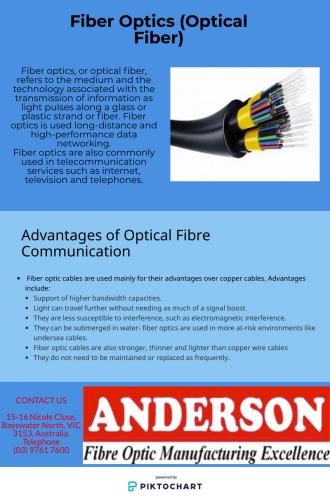The Impact Of Fiber Optics On Our Lives

The most important type of media that uses
light is optical fiber. Each fiber consists of a thin strand of glass or
plastic encased in a plastic cover. An atypical optical fiber is used for
communication in a single direction – one end of the fiber connects to a laser
or LED used to transmit light and the other end is connected to a
photosensitive device used to detect incoming light. Two cables are used: one
for carrying information in each direction.” To put it simply, fiber optic
cords are used to move information from one end of the cable to another. A
recognizable example of a fiber optic cord is a landline telephone: when we
speak into the phone, our voices are picked up by the wire and carried into the
wall socket where a different cable then takes our voice to the local telephone
exchange.
The first telephone was invented by Alexander Graham Bell in
1876. The first cellphone was invented by Martin Cooper in 1973. That means
that we were dependent on the fiber optic cables inside Alexander Graham Bell’s
telephone for approximately 97 years!
Another way that fiber optics have impacted our world and the
computer science world is communication between two computers. For information
transmission: “you could hook your computer up to a laser, which would convert
the electrical information from the computer into a series of light pulses.
Then you would fire the laser down the fiber-optic cable. After traveling down
the cable, the light beams would emerge at the other end: your friends’
computer.” The only thing your friend would need is a photoelectric cell to
turn the light pulses back into electrical information that the computer could
understand. This is basically a high tech version of the telephone you make out
of two cans and a string!
Additionally, fiber optic cables are the main way of carrying
information over great distances because they have 3 advantages over old-style
copper cables, which were used previously. The three advantages are less
attenuation, no interference, and higher bandwidth. “Less attenuation basically
means that there is less signal loss when using fiber optics. With no
interference, this means that information is transmitted more reliably with
better signal quality. As for higher bandwidth, we have seen that fiber optic
cables can carry far larger amounts of data than copper cables.”
Now that we’ve discussed the benefits and strong suits of fiber
optics, let’s talk about some of the detriments. There have been nearly a dozen
instances of internet interruption because of fiber optic cables being cut.
This has led to security experts believing that more in-depth measures need to
be taken “to protect the physical infrastructure that underlies the internet:
fiber optic cables.” Attackers are intentionally cutting these fiber optic
cables. The cutting of these cables results in the interference or interruption
of internet, telephone and television services in several large areas. These
cables are being buried several feet underground and span millions of miles along
with being in underground vaults with protective sheathing. However, they are
marked with orange poles and are unmonitored. Causing interruption can be done
by just severing a couple of these fiber optics cables. You can spend a lot of
money on encryption and firewalls, but you also need to cover the basics. At
the end of the day, if you don’t protect the actual transport mechanism, you’re
always going to have a point of vulnerability.”
Telephone
(03) 9761 7600
Email Address
Post Your Ad Here
Comments